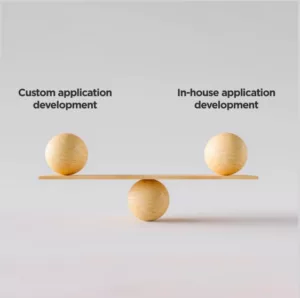The steady increase in outsourced, or custom, application development means revenue for this market is estimated to reach US$122.7bn in 2023 with a CAGR of almost 4.4% for the next few years (Statista). This trend is being driven by the desire for tailored, efficient, and scalable solutions that can give enterprises a competitive advantage and align closely with their specific business goals and requirements.
Regardless of industry, while bespoke enterprise application development may certainly be achieved in-house, outsourcing these efforts is proving to have several incentives. This blog we look at the challenges associated with in-house development, and the drivers and benefits of outsourcing to an application development company.
In-House vs Custom App Development
Custom and in-house application development are two approaches to creating software solutions, each with its own advantages and considerations.
Custom application development involves hiring external software development experts or partnering with a software development company to create a tailored solution from scratch. It allows businesses to leverage specialized skills and expertise, resulting in a highly customized application that precisely meets their unique requirements rather than using off-the-shelf pre-built applications. Although it may feel like relinquishing control or visibility of the development process, these tried and proven delivery processes provide reassurance.
In-house application development, on the other hand, involves utilizing the organization’s internal resources and expertise to build software solutions. This approach provides businesses with more control over the development process and allows for faster decision-making and iteration. However, there are a few associated challenges including limited in-house technology expertise, slower time to market, ongoing investments in training, and keeping up with ever-changing technology and compliance requirements.
What is Driving Custom App Development?
There are several reasons why more enterprises are opting for custom application development:
- Tailored to Specific Needs
Custom applications are built to meet the unique requirements of the business. They can be designed to align with specific processes, workflows, and business objectives, providing a tailored solution that fits seamlessly into the organization’s operations. This level of customization often leads to increased efficiency and productivity. - Competitive Advantage
Custom applications can give enterprises a competitive edge by providing unique functionalities or features that are not available in off-the-shelf solutions. This differentiation can help businesses stand out in the market, improve customer satisfaction, and drive business growth. - Scalability & Flexibility
Custom applications can be designed with scalability in mind, allowing them to grow and adapt as the business evolves. They can easily integrate with existing systems and technologies, providing a flexible foundation for future enhancements and integrations. This adaptability is particularly important for enterprises that anticipate growth or have complex and evolving requirements. - Enhanced Security & Data Protection
Custom applications can be built with robust security measures in place, ensuring sensitive data is protected according to the organization’s specific needs and industry regulations. Custom development allows for a greater level of control over security practices, reducing the risk of vulnerabilities associated with widely-used software. - Long-term Cost Savings
While the upfront cost of custom application development may be higher compared to off-the-shelf solutions, in the long run, it can lead to cost savings. Custom applications eliminate the need for ongoing licensing fees or subscription costs associated with commercial software. Additionally, tailored solutions reduce inefficiencies and bottlenecks, which can result in operational cost reductions over time. - Support & Maintenance
Custom application development often comes with ongoing support and maintenance services. This ensures that the application remains up-to-date, secure, and compatible with new technologies. Having a dedicated support team can provide prompt assistance and address any issues that may arise, minimizing downtime and maximizing application performance.
The SourceFuse Approach: 6 Key Benefits
- Faster Development Accelerating time-to-market 35% faster than industry benchmarks with ready-to-deploy containerized applications.
- Unmatched Security & Agility Integrating advanced security tools and services and increasing efficiency with agile practices such as DevOps, continuous integration (CI) and continuous delivery (CD).
- Guaranteed Reliability Using our microservices approach with ARC enables applications to function continuously even if one microservice fails.
- Reduced Cost Eliminating investments in the procurement and maintenance of costly physical infrastructure, as well as removing high licensing costs and vendor lock-ins.
- Enhanced Customer Experience Automatically scaling resources to accommodate peak demand, with zero downtime during upgrades or when new features are being implemented.
- Ensure Portability Developing cloud-native apps that run independently of underlying operating systems and hardware.
Bottom Line
Ultimately, the choice between custom application development and in-house development depends on factors such as the complexity of the project, available resources, budget, and time constraints. The entire process involves system design, coding, testing, deployment, and maintenance, so organizations should carefully assess their capabilities and specific needs to determine the most suitable approach for their software development endeavors.

